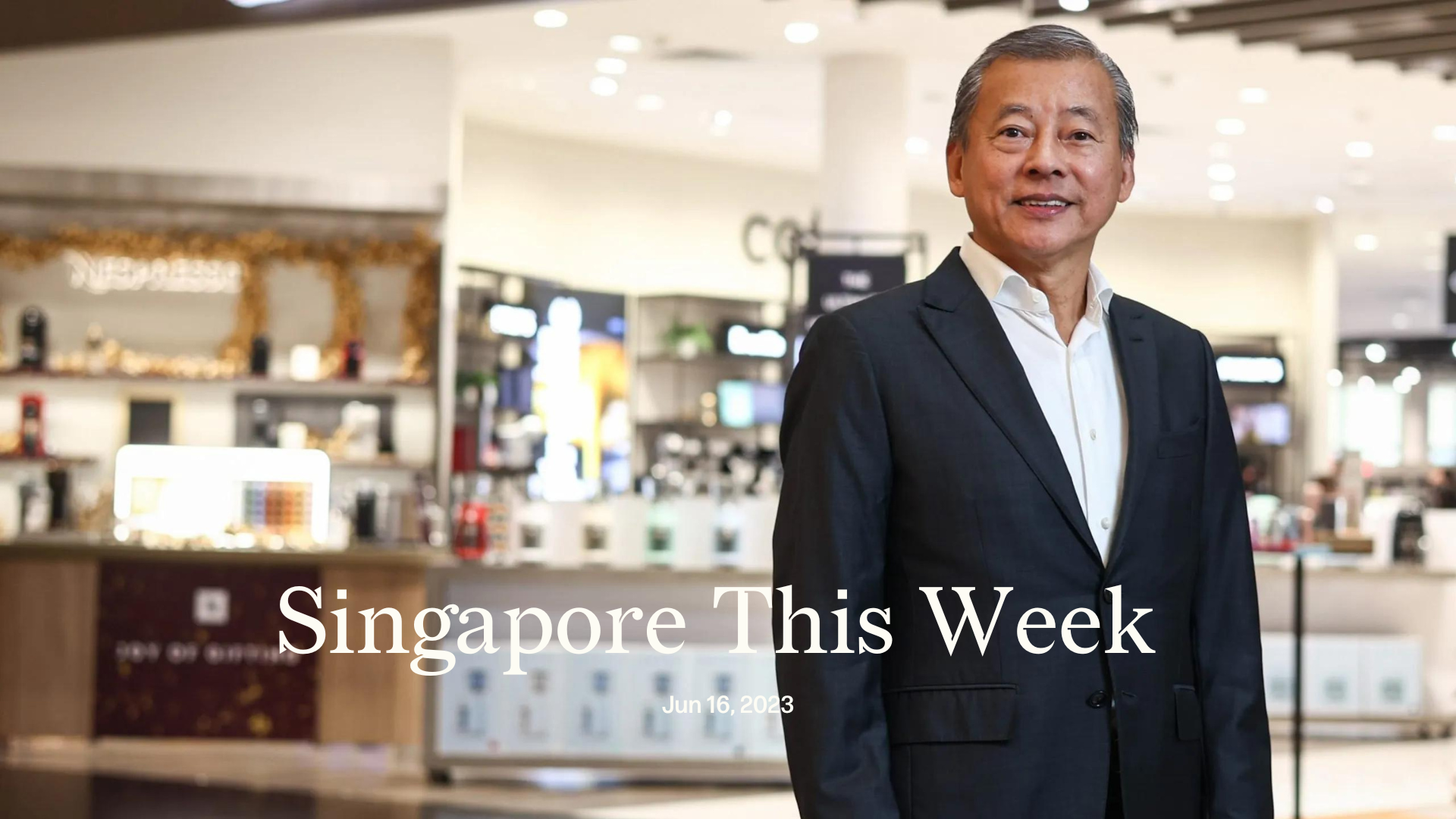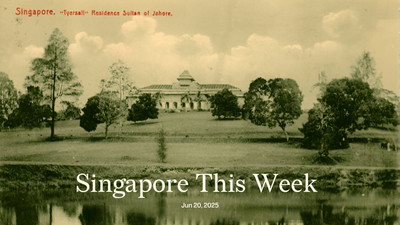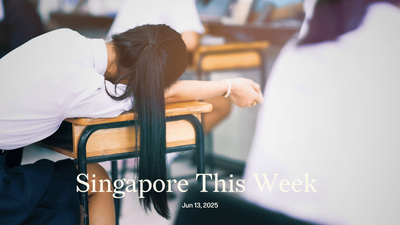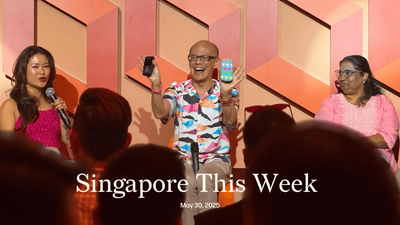Politics: Not the George you’re thinking of
“[Tharman Shanmugaratnam] is a long-time Cabinet minister and has, since his civil service days, been closely involved in public finance policies and institutions…to maintain the integrity of the office, the President must not only be above politics but be perceived as such.” Those lines from George Goh Ching Wah, as he joined the race for the presidency (due by September), encapsulated the thrust of his likely campaign: Tharman’s a forever PAP man; and I’m the true independent. Given that the senior minister is familiar to the electorate while Goh is unknown, the media has been laying out his CV: born in Malaysia into poverty (unlike silver-spooned Tharman); started first business at 22, later founded Harvey Norman Ossia; chairman of publicly-listed Ossia International (his brother is CEO); Singapore’s non-resident ambassador to Morocco since 2017; on the council of the Red Cross Society; a classical singer with a degree from Trinity College London; and involved in numerous philanthropic activities. Goh’s potential candidacy emerged early this year, shortly after he set up his personal website, though it was confirmed only this past Monday. Insiders say that establishment critics may scrutinise his numerous global investments, including any involvement with his brother’s affairs (for instance, alleged improprieties in the manner in which the latter disposed of a Maldivian resort). Some non-establishment criticisms sent to Jom, by contrast, seem to be taking aim at Goh’s conservative Christian views. It was curious that salt&light, a Christian e-zine, published a seeming scoop of Goh a week before he announced his candidacy. In it he boasted about proselytising in the Himalayas, the world’s “unreached areas”. The Christian right, one theory goes, will back Goh partly to show its displeasure at the ruling People’s Action Party (PAP) for last year repealing S377A, the law that criminalised sexual relations between men. All this could be early speculation, but if true, then Goh may have the support of an odd coalition—everybody from church goers to anything-but-PAP secularists.
Politics: The Ho you’re thinking of
Last year, one theory had it that Ho Ching, former boss of Temasek and wife of Lee Hsien Loong, the prime minister, might be a contender for the presidency. Even if true, Tharman has pipped her as the PAP’s candidate. And, as any observer of her Facebook page will know, she will still have her say. In this week’s exposition, outlining her vision of the presidency and its duties, she seemed eager to downplay the office’s powers, making clear that the “primary role” is ceremonial and that the safeguarding of reserves and the integrity of institutions was but a “secondary role”. She also included what appears like direct warnings to Tharman, and others who may envision an expanded role: “It is not to be an independent voice, a check on govt, or an ombudsman to all the woes and ills of society”; and “...don’t fly the false flag of independence, check and balance.” Just a few days prior, Tharman was specifically asked about his independence. “But those who know me, know me quite well. They know who I really am and my views. So I’ll talk about that later. I really don’t want to get into what appears to be campaign messaging at this point.” Will Tharman (if elected) check the government? Or will Ho check him?
Society: Healthy employees, healthier bottom lines
Companies are taking the well-being of their employees more seriously, because, let’s face it, it makes business sense. Take care of your people and you’ll likely be better at attracting and retaining talent. Happy employees are also as much as 20 percent more productive than unhappy ones. According to insurers that The Straits Times spoke to, a growing number of businesses are including mental health benefits in their corporate insurance coverage. AIA Singapore, for instance, saw 10 percent of its corporate customers add mental health coverage this year, compared to a measly 1 percent before 2020. For specialist referrals at Great Eastern, coverage jumped from 0.9 percent to 7.7 percent in the same period. Overall, said consulting firm Mercer Singapore, the median mental health coverage limit has increased from S$750 to S$5,000 per policy year from 2019 to 2021. The pandemic has accelerated these changes. Burnout was one of the most-cited reasons for job dissatisfaction that led to “The Great Resignation”, a wave of people quitting post-Covid. But insurance policies and coverage vary depending on budget, from access to out- and inpatient treatment by psychologists and psychiatrists, to the more basic 24/7 counselling hotline. These efforts could be given a filip—as ever, in market-governed Singapore—by news that anxiety and depression could cost the city-state almost S$16bn a year: over 81 percent of which is due to presenteeism (reduced productivity at work); over 14 percent due to absenteeism; and under 5 percent due to the use of healthcare resources. Still, will employees feel safe enough to seek professional help given the perceived stigma around mental illness? Supporting employees’ mental health is surely a positive step towards improving their work environment. But what’s more essential perhaps is creating a company culture that protects and prioritises employees’ welfare in a holistic way: like paying a fair and equitable wage; respecting work-life balance; offering flexibility and autonomy; while not forgetting that low-income, blue collar workers count too.
Society: Singapore’s climate karma
Imagine if the atmosphere were treated as a common natural resource from 1960, and each country had a fixed, sustainable “carbon budget” to spend, varying by population size. Who has overspent to the detriment of the environment? And how should they now compensate the rest of the world? That’s the premise of a new study in Nature Sustainability. By utilising a hypothetical ‘net zero’ scenario where all countries decarbonise by 2050, Andrew L Fanning and Jason Hickel quantified the compensation owed to countries who underutilised their share of the carbon budget—permissible cumulative greenhouse gas emissions, allocated fairly by population size, so as to limit global warming to 1.5°C (a commonly used benchmark in climate studies). By comparing this carbon budget against the actual cumulative emissions across 168 countries since 1960, Hickel and Fanning concluded that the global north (eg. Australia, Canada, Europe, New Zealand, the US) has exceeded their share of the budget by a factor of three, effectively appropriating half of the global south’s share. “Climate change reflects clear patterns of atmospheric colonisation,” said Hickel. The US alone has exceeded its share of the carbon budget by more than four times and would be liable for US$80tn (S$107.2tn) in reparations. “...if we are asking nations to rapidly decarbonise their economies, even though they hold no responsibility for the excess emissions that are destabilising the climate, then they should be compensated for this unfair burden,” argued Fanning. Based on their calculations, Singapore would need to cough up a good amount for reparations: our cumulative emissions is a whopping 2.5 times our “fair share” of the carbon budget. We’re one of the top five global south emitters, alongside Qatar and the United Arab Emirates. Hickel and Fanning likely won’t be on the reading list of Grace Fu, sustainability and environment minister. She recently said that Singapore might be a “potential claimant” to the “loss and damage” fund, an international fund meant for developing nations coping with the destructive effects of climate change: bizarre, and a bit rich.
Society: TJFest by TJC
“Breaking Chains: Towards Gentle Futures”, this year’s inaugural community arts, culture and knowledge festival by abolitionist group Transformative Justice Collective (TJC), takes place across three venues over three weekends, starting July 1st. TJC has been instrumental in pushing for the reform of Singapore’s criminal justice system. Its recent death penalty activism has been fervent: holding rallies; advocating for prisoners’ rights; rousing action and discourse around capital punishment and Singapore’s drug control regime; and providing social support to death row prisoners and their families. “Abolition,” explained TJC, “is as much a project of collective re-imagination, experimentation and creation as it is a project of dismantling oppressive systems of surveillance and punishment.” There’ll be experiential workshops, film screenings, storytelling, artmaking, music, games, poetry, talks, panel discussions and community conversations over food and drink. Former prisoners will also be running a shop called, “For Sale: Objects Other Than Our Bodies”, an art installation and several booths. See the full programme and register for events here.
Society: Singapore’s first independent media fair
Jom will be at the first-ever Singapore Independent Media Fair, organised by New York-based literary non-profit Singapore Unbound and literary magazine Mekong Review. Created with the goal of fostering connections and building solidarity, the fair serves as an opportunity to galvanise our local independent media community. Its exhibition includes booths from local media outlets, such as Kontinentalist, New Naratif and Wake Up Singapore (WUSG) as well as publishers like Ethos Books. The festival will also host two discussion sessions: an open forum “Why Do We Need an Independent Media?”, featuring Ariffin Sha of WUSG, Loh Pei Ying of Kontinentalist, and Ng Kah Gay of Ethos, moderated by Jom’s Sudhir Vadaketh; and an author reading and discussion on “The Uses of Storytelling”, featuring playwright Alfian Sa’at, Kelly Leow of AWARE (and co-writer of its “Saga” podcast) and speculative fiction writer Victor Fernando R Ocampo, moderated by Singapore Unbound’s Koh Jee Leong. The fair will be held on July 1st and entry is free. Register on Eventbrite.
Arts: The most ambitious crossover event in history
Two cinema operators are collaborating on a new venue, due to open this December, and bearing their clunky, combined name: Golden Village x The Projector at Cineleisure (GVxTP). Golden Village will programme blockbuster movies and The Projector will screen their usual fare of independent, cult, and arthouse films at the Cathay Organisation’s Cineleisure Orchard building. Cathay Cineplexes currently occupies the cinema at Cineleisure but will hold its last day of screening on June 30th. The new venue will also host a day-to-night cafe and bar concept. It’s good news for fans of The Projector, which is winding down its pop-up, Projector X: Picturehouse. (The Cathay on Handy Road, where it’s housed, is closing for redevelopment works.) In honour of Picturehouse’s success, The Projector is programming a series of films that celebrate the art of cinema as well as some of their greatest hits. The closing screening will be a repeat of Tommy Wiseau’s “The Room”, a film shown at The Projector several times a year to large and boisterous crowds. The final day of operation, July 9th, is reserved for a noon to midnight party with Salsa Y Comida, Kampong Boogie and EatMePopTart. Tickets and more information for Swansong: Picturehouse can be found on The Projector’s website.
Arts: Singaporean music goes global
NME, an international music website, has profiled three Singaporean hardcore bands—Doldrey, Fuse and Sial—who are about to (coincidentally and independently) embark on tours of Europe and the UK. Sial, which plays 80s’-inspired punk, is the veteran group of the three and has performed internationally. Doldrey, which plays deathpunk, and Fuse, an all-female band that takes reference from the riot grrrl era, will be touring Europe for the first time. This post-pandemic season has proved fruitful for Singaporean musicians taking their shows abroad. Emo band Forests recently concluded a successful American tour, even landing coverage in The New York Times. Meanwhile, in Japan, alt-rock band Blush played shows with Forests, and also joined indie pop group Sobs on its tour of the country. Blush, Forests and Sobs all share performers—Soffi Peters plays in Blush and Sobs, and Daniel Lim plays in Blush and Forests. The members of Fuse, Doldrey and Sial also work closely and have started side projects together. It’s a lot to keep track of, but entirely unsurprising considering how close-knit and mutually dependent the Singaporean music scene is.
History weekly by Faris Joraimi
Last Wednesday, Merdeka-fighter Lim Kean Chye died at 103. Lim was involved in the first constitutional struggle for Malayan independence immediately following the Japanese Occupation: led by the leftist All-Malaya Council for Joint Action (AMCJA). One of AMCJA’s member-parties, the Malayan Democratic Union (MDU), was founded by Lim. But the British had other plans and launched the Malayan Emergency in July 1948. AMCJA dissolved, “ending the MDU phase of the Malayan Dream”, in historian Hong Lysa’s words. Lim’s profile was consistent with his comrades in the MDU: wealthy background, Cambridge-educated, and a lawyer. As intellectuals, they had to work with the one movement popular and organised enough to fight the British, the Malayan Communist Party (MCP). In 1949, after returning from England, Lim joined an MCP-backed group called the Anti-British League with former MDU-mate Eu Chooi Yip and P V Sarma. This circle consisted of James Puthucheary (uncle of Janil Puthucheary), Devan Nair (Singapore’s third president) and A Samad Ismail (founder of the PAP). All were arrested in a 1951 British swoop, except Eu and Lim, who fled. A 10,000-Malayan-dollar reward was placed for Lim’s capture. He took various boats out, eventually ending up in Canton, where he had to write his whole life story in Mandarin (which, being Anglophone, was tough) before working as a translator for a bed and one dumpling a day. David Marshall, Singapore’s first chief minister, met him there, delighted that China had given Lim, an ethnic-Chinese, foreigner status. Lim returned to Singapore when he thought Lim Yew Hock, his old friend replacing Marshall as chief minister in 1958, would go easy on him. Unfortunately, Yew Hock was even tougher on communists, and Lim was arrested. But the Board of Appeals released him—apparently all the judges were also his friends—though Lim couldn’t enter politics. Tunku Abdul Rahman, another fellow Cambridge old boy who invited him to move to Malaysia, also banned him from politics. Does it pay to have kakis in high places, if they make you lay low?
Tech: Robotic Singapore
Amid recent hype about how generative AI (artificial intelligence) will replace white-collared work, Singapore has been investing in robots that could replace manual work across labour-intensive industries such as F&B, logistics and manufacturing. This is unsurprising given the perennial labour crunch the country faces with its small population and tightening immigration quotas. For one, Ross Digital, a robotics firm for the F&B industry is automating cooking processes, from making coffee to cleaning dishes, in partnership with the Singapore government, which has invested S$3.5m in the project. These robots won’t just be at high-end restaurants but will also be deployed at selected hawker centres in Singapore. Meanwhile, the Nanyang Technological University (NTU) has jointly invested S$24m with Taiwan-based Delta Electronics to start the Delta-NTU Corporate Lab for Advanced Robotics. It’ll develop robots for more complex settings, such as in the manufacturing and logistics industries. They’ll have, for instance, grip-adjusting abilities and smart sensing systems to work with fragile and hazardous materials. At the end of the day, both AI and robotics are two sides of the same coin—increased automation of manual and repeatable tasks. Whether that necessarily means less jobs or better jobs will be a function of whether Singaporeans can build human skills that are irreplaceable by technology.
Tech: WhatsApp struggles to keep pace with Telegram
WhatsApp finally announced the launch of its Channels feature in Singapore, only the second market after Colombia to offer the new feature. It’s akin to Instagram’s new “Channels” feature, which allows creators to broadcast one-way messages directly to their followers, increasing their engagement. WhatsApp’s Channels will initially only be accessible to early-access partners, such as the Ministry of Communications and Information, the Land Transport Authority, the Ministry of Home Affairs, and the Singapore Heart Foundation. While WhatsApp wants to eventually make access ubiquitous, Telegram has since 2015 allowed every user to start their own channels. Organisations such as Gov.sg already have over 267,000 subscribers. Individuals are also increasingly using their Telegram personal channels to post daily updates, almost like an Instagram story. Given the increased competitive threat of Telegram to both WhatsApp and Instagram, it’s unsurprising that Meta, WhatsApp’s owner, is finally launching this feature—albeit eight years late. Neither WhatsApp nor Telegram run ads yet. The former is funded by its parent while the latter is a non-profit funded by philanthropy—although its paid “Premium” service now has over 1m subscribers. WhatsApp still has a far larger overall user base—2bn monthly active users compared to Telegram’s 700m. Perhaps that’s one reason for its complacency.
If you enjoy Jom’s work, do get a paid subscription today to support independent journalism in Singapore.








